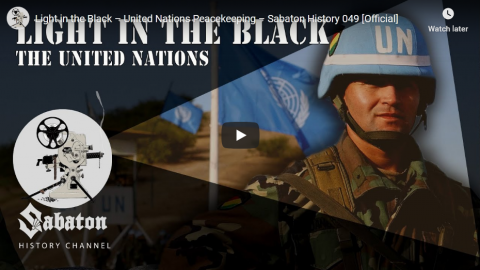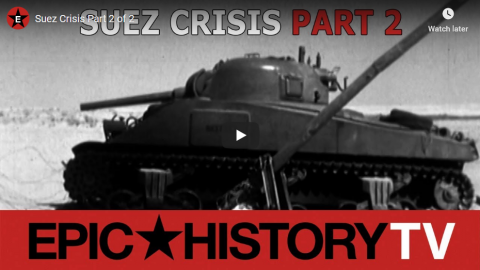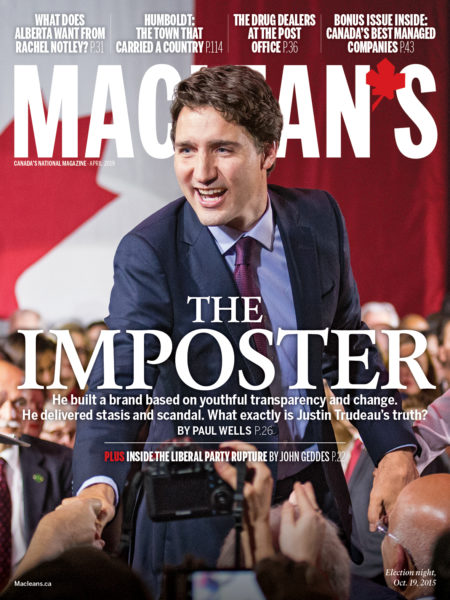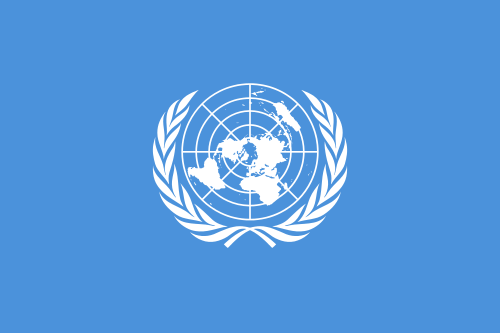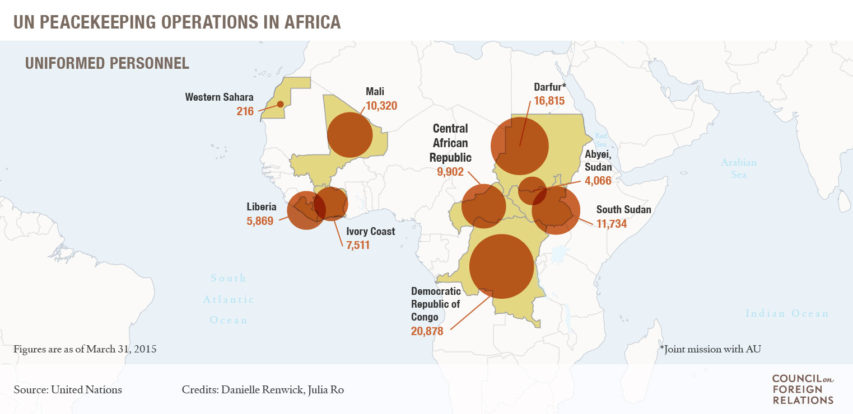Forces News
Published Jul 20, 2024Nicosia International Airport was once a busy hub full of holidaymakers but since the Cyprus conflict of 1974, it has been frozen in time.
Today, the disused airport resembles a ghost town as it sits abandoned in the 180km buffer zone dividing the Republic of Cyprus and the Turkish-occupied north.
On the 50th anniversary of the conflict, Forces News goes inside the eerie airport and learns how it became the site of a major battle.
(more…)
November 26, 2024
The ghost airport of Nicosia: Rare glimpse inside the abandoned 1974 battleground
July 15, 2024
Revisiting the “official” story of Srebrenica
Niccolo Soldo’s weekly roundup includes a look at the differences between the story the media told us about the Srebrenica massacre and what has come to light since then:
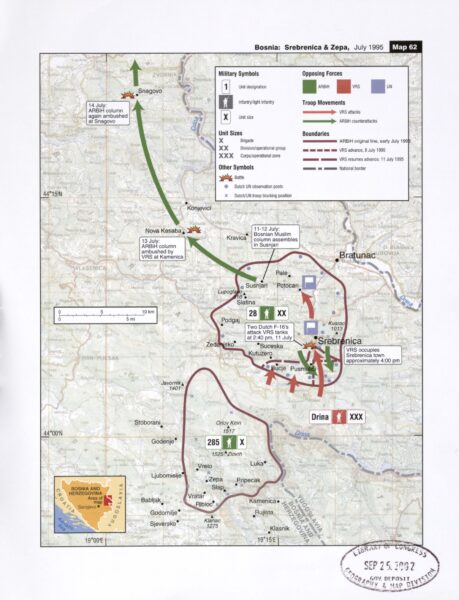
Map of military operations on July, 1995 against the town of Srebrenica.
Map 61 from Balkan Battlegrounds: A Military History of the Yugoslav Conflict; Map Case (2002) via Wikimedia Commons.
29 years ago this week, Bosnian Serb forces of the VRS managed to seize the town of Srebrenica in Eastern Bosnia, on the border with Serbia. A massacre of Bosnian Muslim males ensued shortly thereafter, and the narrative of genocide sprung forth quickly from it, giving cause to NATO’s intervention in that conflict.
Did a massacre occur? Certainly. Some 2,000 Bosnian Muslim males were summarily executed by Bosnian Serb forces around Srebrenica shortly after the UN-designated “safe haven” fell to the Serbs. Some 8,000 Bosnian Muslims lost their lives in the immediate aftermath of the fall of Srebrenica, but the narrative of “genocide” whereby all 8,000 were executed is simply not true as per John Schindler, the then-Technical Director for the Balkans Division of the NSA:
Twenty-nine years ago today, the Bosnian Serb Army captured Srebrenica, an isolated town in Bosnia’s east that was jam-packed with Bosnian Muslims, most of them refugees. This small offensive, involving only a couple of battalions of Bosnian Serb troops, soon became the biggest story in the world. What happened around Srebrenica in mid-July 1995 permanently changed the West’s approach to war-making and diplomacy.
The essential facts of the Srebrenica massacre are not in dispute. The town was a United Nations “safe area” but U.N. peacekeepers there, an understrength Dutch battalion, failed to protect anyone. Over the week following Srebrenica’s quick fall, some 8,000 Bosnian Muslims, almost all male, a mix of civilians and military personnel, were killed by Bosnian Serb forces. About 2,000 disarmed Bosnian Muslim prisoners of war were executed soon after the town’s capture. The rest died in the days that followed, all over eastern Bosnia.
As the world learned the extent of the massacre, by far the biggest atrocity in the Bosnian War that had raged since the spring of 1992, Western anger mounted. Six weeks later, President Bill Clinton ordered the Pentagon to bomb the Bosnian Serbs in Operation Deliberate Force, the first major military action in NATO’s history. By the year’s end, the war was concluded by American-led diplomacy.
Here are Schindler’s conclusions:
That for three years, Srebrenica, supposedly a U.N. “safe area,” served as a staging base for Bosnian Muslim attacks into Serb territory. The Muslim military’s 28th Division regularly attacked out of Srebrenica. Bosnian Serbs claim they lost over 3,000 people, civilian and military, to those attacks.
That the Bosnian Muslim commander at Srebrenica, Naser Oric, was a thug who tortured and killed Serb civilians (he showed Western journalists footage of his troops decapitating Serb prisoners), as well as fellow Muslims he disliked. Mysteriously, Oric fled Srebrenica three months before the town’s fall, leaving his troops to die.
That most of the Bosnian Muslim dead, some three-quarters of them, died not at Srebrenica but during an attempted breakout by troops of the 28th Division to reach their own lines around Tuzla. They showed little communications discipline, and Bosnian Serb forces called down their artillery on them, columns of Muslim military and civilians together, slaughtering them. This doesn’t meet any standard definition of genocide.
That the Muslims were flying weapons into the “safe area” by helicopter in the months before the Bosnian Serb offensive. (Controversially, the Pentagon knew this was happening but pretended it didn’t.) The Serbs repeatedly protested to the U.N. about this violation, to no avail. This was the reason for the offensive to take the town.
There’s also convincing evidence that the Muslim leadership in Sarajevo knew Srebrenica would be attacked and allowed it to fall. Their leader, Alija Izetbegovic, stated that if Srebrenica fell, the Serbs would massacre Muslims as payback, and America would intervene on the Muslim side in the war. He was right.
Some of you may not like what John has to say here about Gaza and how it relates to Srebrenica:
This isn’t merely a historical matter. What happened in Bosnia is being repeated today in Gaza. Western journalists uncritically accept Muslim claims about war crimes and “genocide” to smear a Western state that’s at war with radical Islam.
Here the strange ideological affinity between jihadists and the Western Left plays a role, as it did during the Bosnian War as well. No claims of war crimes, which possess great political value on the world stage, should be accepted without independent confirmation. Srebrenica should have taught Western elites this essential truth, but it didn’t.
On a personal note, I like to bring up Srebrenica to Serbs as an example of how media shapes narratives that are often very remote from the truth in the hope that they understand what I am saying in a wider context.
Fun fact: Srebrenica translates into “Silverton”, as it was a significant silver mining town during the late Medieval era, with imported Saxons running the show.
June 18, 2023
QotD: Good intentions do not automatically mean good results
The United Nations Children’s Fund is probably the greatest mass-poisoner in human history — not deliberately, of course, but inadvertently. It encouraged and paid for the drilling of tube wells in Bangladesh without realizing that the groundwater was dangerously high in arsenic content. It promoted the wells to reduce the infant mortality rate from infectious gastroenteritis and in this it succeeded. Indeed, it trumpeted its success to such an extent that it found it hard to recognize that, in the process, it had exposed tens of millions of people to arsenic poisoning, and was very late in recognizing its responsibility in the matter.
Another United Nations agency, its peacekeeping force in Haiti, was responsible for the most serious epidemic of cholera of the twenty-first century so far. Before 2010, cholera had been unknown in Haiti despite the country’s poverty and lack of hygiene. Then, from 2010 to 2018, it suffered outbreaks of cholera that have affected perhaps a tenth of the population and caused between 10,000 and 80,000 deaths (the exact figure will never be known).
The evidence suggests that cholera was brought to Haiti by United Nations peace-keeping troops from Nepal. Whether Haiti needed peacekeeping troops at all may be doubted: at the time it suffered from civil unrest rather than from war. One suspects that the peacekeeping force was employed more to keep the Haitians from leaving Haiti than to keep the peace.
Be that as it may, some Nepali troops arrived fresh from a cholera epidemic in Nepal, established a camp next to the Artibonite River from which many Haitians drew their water. The Nepalis emptied their sewage directly into the river, and some of them were infected with the cholera germ. There was soon an outbreak of cholera among the local population of extraordinary violence. The Haitians guessed at once that the Nepali troops had brought the cholera, but this was strongly denied.
Theodore Dalrymple, “Negligence and Unaccountability at the United Nations”, New English Review, 2019-07-09.
January 2, 2023
How much of the media coverage of the Bosnian War was fake news?
Kate at Small Dead Animals linked to this rather disturbing collection of intelligence cables from the Canadian peacekeeping force in Bosnia to NDHQ in Ottawa during the conflict, which contradicts the media narrative of the time:
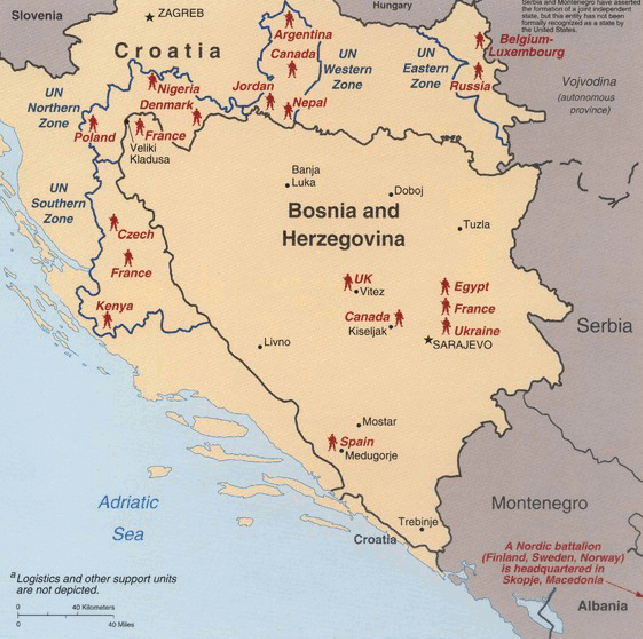
Map of deployment of National Battalions in UN Forces in Croatia and Bosnia and Herzegovina – Early 1993 (Balkan Battlegrounds Map I)
Balkan Battlegrounds: A Military History of the Yugoslav Conflict, 1990-1995 author credit: Central Intelligence Agency.
A trove of intelligence files sent by Canadian peacekeepers expose CIA black ops, illegal weapon shipments, imported jihadist fighters, potential false flags, and stage-managed atrocities.
The established mythos of the Bosnian War is that Serb separatists, encouraged and directed by Slobodan Milošević and his acolytes in Belgrade, sought to forcibly seize Croat and Bosniak territory in service of creating an irredentist “Greater Serbia”. Every step of the way, they purged indigenous Muslims in a concerted, deliberate genocide, while refusing to engage in constructive peace talks.
This narrative was aggressively perpetuated by the mainstream media at the time, and further legitimized by the UN-created International Criminal Tribunal for the former Yugoslavia (ICTY) once the conflict ended. It has become axiomatic and unquestionable in Western consciousness ever since, enforcing the sense that negotiation invariably amounts to appeasement, a mentality that has enabled NATO war hawks to justify multiple military interventions over subsequent years.
However, a vast trove of intelligence cables sent by Canadian peacekeeping troops in Bosnia to Ottawa’s National Defence Headquarters, first published by Canada Declassified at the start of 2022, exposes this narrative as cynical farce.
The documents offer an unparalleled, first-hand, real-time view of the war as it developed, with the prospect of peace rapidly degrading into grinding bloodshed that ultimately caused the painful death of the multi-faith, multi-ethnic Yugoslavia.
The Canadian soldiers were part of a wider UN Protection Force (UNPROFOR) dispatched to former Yugoslavia in 1992, in the vain hope tensions wouldn’t escalate to all-out-war, and an amicable settlement could be reached by all sides. They stayed until the bitter end, long past the point their mission was reduced to miserable, life-threatening failure.
The peacekeepers’ increasingly bleak analysis of the reality on the ground provides a candid perspective of the war’s history that has been largely concealed from the public. It is a story of CIA black ops, literally explosive provocations, illegal weapon shipments, imported jihadist fighters, potential false flags, and stage-managed atrocities.
Read the complete Canadian UNPROFOR cables here.
See key excerpts of the files referred to in this article here.
March 17, 2022
The “Three-Block”, “Four-Block”, or “n-Block” war
In The Line, Andrew Potter explains the genesis of the original “Three-Block War” idea and how a Canadian general tried to put theory into practice:

During General Rick Hillier’s first visit to Colorado Springs as Chief of Defence Staff, he takes a few minutes to talk with Tech. Sgt. Devin Fisher of NORAD and USNORTHCOM Public Affairs about Canada-U.S. Relations
Public domain image via Wikimedia Commons.
In 1999, a US Marine general named Charles Krulak wrote a piece in which he claimed that the future of combat for the Marines would be in urban environments in failed or failing states. In these situations, front line infantry might be doing humanitarian relief in one part of the city, performing peacekeeping duties in another, while doing intense urban combat in a third. He called this the “Three Block War“. Figuring out how to prepare and train for this scenario would be the central military challenge of the 21st century.
While the Three Block War was picked up and booted around as an interesting idea, it was never formalized into Marine doctrine. But one person who did take it seriously was Rick Hillier, the former head of the Canadian military who brought it into the Canadian forces when he took over as chief of the land staff in 2003, arguing that the Three Block War in failed and failing states was the future of warfare. He wanted a CAF that was trained and kitted out for this reality. When he became Chief of the Defence Staff in 2005, Hillier kept pushing this idea on Paul Martin and the Liberals, who loved his “vision” and firm sense of priority-setting.
In Hillier’s hands, the Three Block War concept was a disaster. Some American analysts blamed the strategy for Canada’s elevated casualty rates in Kandahar. The concept also came under considerable scrutiny from Canadian military analysts. In a highly critical paper, Walter Dorn and Michael Varey described the three block war idea as “fatally flawed“. While the Three Block War concept might have served as a useful description of a certain type of tactical reality (amplified maybe by a few too many viewings of Black Hawk Down), as a strategic concept it had a number of problems. For example, it wasn’t clear how it would apply to other armed services, or to theatres other than urban centres. It seemed to threaten the specificity of mandate and mission that is crucial to military operations. It clearly ran the risk of “block inflation” — why not throw governance, economic development, general nation building, and anything else you think you can get the military to do into the hopper? Indeed, in 2005 General James Mathis co-authored a piece proposing the concept of the four block war, which added psychological and information operations to the mix.
Ultimately, Dorn and Varey were concerned that crucial distinctions central to warfare were being elided. As they put it, the whole point of doctrine is to make a clear delineation between things that are “war” and things that are “not war”, and the Three Block War threatens to make everything into a type of war.
Two decades later the verdict is in, and it looks like everyone was right. When it comes to the tactical environment, people like Krulak, Hillier, and Mathis were more prescient than they might ever have imagined, at least if Ukraine is any template for how modern warfare is evolving. Yet at the same time, everything the critics of the Three Block War concept worried about has also come to pass: the confusion of mission and mandates, the endless proliferation of “blocks”, and most seriously, the assimilation of everything, and everyone, into “war”.
In his original article, Krulak argued that the reality of the Three Block War meant that any local engagement or interaction could have repercussions on the mission as a whole. For example, if a squad of Marines based in a “peacekeeping” block of the city gets jumpy and opens fire on a civilian truck carrying humanitarian aid (and not a truck bomb), that could have serious impacts for the entire strategic effort. And so he coined the notion of the “strategic corporal”, a front line soldier who would have the training, judgement, and moral fibre to do his or her job in a way that would always support strategic objectives.
February 14, 2022
QotD: Canadians and imaginary peacekeeping
… the word “peacekeeping” triggers a series of powerful memories and positive images in the Canadian mind: Lester Pearson’s Nobel Peace Prize; a Canadian soldier in a blue helmet interposed between warring factions; the peacekeeping monument in Ottawa, and the widely believed mantra that, while Americans make war, we Canadians keep the peace.
Canadians are fixated on peacekeeping. We believe that Mike Pearson invented it, that Canadians are the best in the world at it, and that if we do peacekeeping, ideally for the United Nations, then we will not need large numbers of troops or much expensive equipment. The idea of peacekeeping as our métier has certainly shaped Canadian defence policy, and not for the better. The billions of dollars that Liberals and Conservatives have belatedly pledged to rebuild the Canadian Forces will take years to make a difference and to undo four decades of neglect …
J.L. Granatstein, “Wake up! This is our war, too”, Globe and Mail, 2006-02-28.
May 24, 2020
Justin Trudeau explains why Canada is still ferociously invested in getting that temporary UN Security Council seat
Chris Selley strives manfully to avoid directly calling the Prime Minstrel of Canada an utter moron:
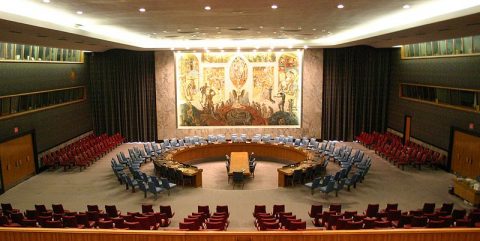
The United Nations Security Council Chamber in New York, also known as the Norwegian Room.
Photo by Patrick Gruban via Wikimedia Commons.
“We are doing well managing the economy in the COVID era while keeping to the principles and values that we hold dear,” said Trudeau.
There are times when the prime minister opens his mouth and I genuinely wonder how he doesn’t burst into flame. This was one of those times.
Which principles and values exactly?
Not our international obligations to asylum-seekers, certainly. Until very recently the Liberals would shift into maximum dudgeon at the very suggestion that tens of thousands of people crossing the border “irregularly” — let no one say “illegally”! — at Roxham Road constituted any sort of problem.
“FACT: Providing asylum claimants due process is not a choice. It is the law,” then Immigration Minister Ahmed Hussen tweeted in July 2018. Trudeau was dispatched to Queen’s Park to educate Premier Doug Ford, who wasn’t being welcoming enough. “It didn’t seem to me that the premier was quite as aware of our international obligations to the UN convention on refugees, as he might have been,” Trudeau faux-lamented. “So I spent a little time explaining.”
And then in March, it all got chucked into the incinerator. Try to cross the border illegally — we can say it now! — and you’ll get turned back into American custody.
Plus the sardonic amusement that Canada, whose educational and cultural organizations make such a big deal about our critical role in UN peacekeeping over the years, currently has a massive force deployed on such missions … thirty five in total … that’s not 35 missions, that’s 35 people.
February 8, 2020
QotD: Canadian peacekeeping, myth and reality
In fact, why don’t we practise anything we preach? As of May 2005, the top contributors to UN operations were Pakistan, Bangladesh, India, Nepal at Number 4, good grief, and they’re practically on the brink of civil war. Well, okay, we’re not in the Top 10 with all that expendable Asian manpower but c’mon, we must be in there somewhere … Number 20) France; 24) Ireland; 29) United Kingdom; 30) United States … hey, how’d those two warmongers make the Top 30 peacekeepers? Wait a minute, here we are: Canada, rocketing into the Hit Parade at 33 with a lack of bullet, right between Togo and Turkey. But, to the best of my knowledge, Togo and Benin (28) and Senegal (12) don’t regard peacekeeping as so indispensable to their self-image that they stick it on their currency and brag about it in beer commercials.
So we’re no longer a great military nation. But nor are we a great peacekeeping nation: we do less than notorious sabre-rattlers like Britain and America. Compared to the Scandinavians and the other niceniks we’re a poor aid donor, and our immobile rapid-reaction force is of no practical use in humanitarian crises. M. Chrétien’s legacy-building Africa initiative of 2002 is known only to Canadians. Everywhere else, it’s credited as Tony Blair’s Africa initiative. We have less influence internationally than we did in the 1940s — before we had a flag, an anthem, or our own citizenship. Even if the Trudeaupian vision of Canada were sufficient for a national identity, it suffers from the basic defect of being a bald-faced lie.
Mark Steyn, “Nothing to see here”, Western Standard, 2005-08-08.
January 10, 2020
“Light in the Black” – United Nations Peacekeeping – Sabaton History 049 [Official]
Sabaton History
Published 9 Jan 2020The United Nations were created to avoid any future human suffering and all-out conflict. Numerous peacekeeping missions had the goal to deescalate and protect the innocent. However, the success and usefulness of the UN is still quite ambiguous. The Sabaton song “Light in the Black” is about the UN peacekeeping missions and we tell you about the history.
Support Sabaton History on Patreon: https://www.patreon.com/sabatonhistory
Listen to Attero Dominatus (where “Light in the Black” is featured):
CD: http://bit.ly/AtteroDominatusStore
Spotify: http://bit.ly/AtteroDominatusSpotify
Apple Music: http://bit.ly/AtteroDominatusAppleMusic
iTunes: http://bit.ly/AtteroDominatusiTunes
Amazon: http://bit.ly/AtteroDominatusAmzn
Google Play: http://bit.ly/AtteroDominatusGooglePlayListen to Sabaton on Spotify: http://smarturl.it/SabatonSpotify
Official Sabaton Merchandise Shop: http://bit.ly/SabatonOfficialShopHosted by: Indy Neidell
Written by: Markus Linke and Indy Neidell
Directed by: Astrid Deinhard and Wieke Kapteijns
Produced by: Pär Sundström, Astrid Deinhard and Spartacus Olsson
Creative Producer: Joram Appel
Executive Producers: Pär Sundström, Joakim Broden, Tomas Sunmo, Indy Neidell, Astrid Deinhard, and Spartacus Olsson
Production Intern: Rune Væver Hartvig
Post-Production Director: Wieke Kapteijns
Edited by: Iryna Dulka
Sound Editing by: Marek Kaminski and Karolina Dolega
Maps by: Eastory – https://www.youtube.com/c/eastoryArchive by: Reuters/Screenocean https://www.screenocean.com
Music by Sabaton.Sources:
RijksmuseumAn OnLion Entertainment GmbH and Raging Beaver Publishing AB co-Production.
© Raging Beaver Publishing AB, 2019 – all rights reserved.
October 10, 2019
Suez Crisis Part 2 of 2
Epic History TV
Published on 28 Dec 2017In 1956, an international crisis over control of the Suez Canal put Britain and France into direct conflict with President Nasser of Egypt, a proud Arab nationalist determined to stand up to foreign powers meddling in Egyptian affairs.
Part 2 explores how Britain, France and Israel cooked up a secret plan to invade Egypt, overthrow Nasser and reassert their standing as global powers. But when the international community, and in particular the United States, condemned their actions, the aggressors were forced into a humiliating climbdown. The repercussions for the Middle East and global history were long-lasting and profound.
Archive film from AP Archive http://www.aparchive.com/
Music from Filmstro https://www.filmstro.com/
Get 20% off an annual license! Use our exclusive coupon code:EPICHISTORYTV_ANNHelp me make more videos by supporting Epic History TV on Patreon https://www.patreon.com/EpicHistoryTV
Further Reading on Suez Crisis (click affiliate links to buy on Amazon & support the channel):
Blood and Sand, Alex von Tunzelmann (Simon & Schuster, 2016) http://geni.us/QyoWs
Suez: Britain’s End of Empire in the Middle East, Keith Kyle (I.B.Tauris, 2011) http://geni.us/aqn6AH
The Suez Crisis 1956, Derek Varble (Osprey, 2003) http://geni.us/ANxBQEE
“Suez 1956”, Timothy Benson in History Today (Nov 2006)
“Suez: The Canal Before the Crisis”, Steve Morewood in History Today (Nov 2006)
“Nasser, Suez and Arab Nationalism”, Michael Scott-Baumann in History Today (Mar 2010)
“The First Suez Crisis”, Christopher Danziger in History Today (Sep 1982)
The Suez Crisis, by Laurie Milner, BBC website http://www.bbc.co.uk/history/british/…
“Andrew Bacevich reviews ‘Eisenhower 1956′”, London Review of Books (Vol.33 No.12)
“Avi Shlaim reviews ‘Israel’s Border Wars, 1949-56′”, London Review of Books (Vol.16 No.16)#EpicHistoryTV #SuezCrisis #ColdWarHistory
July 4, 2019
Is there a country with which Justin Trudeau hasn’t messed up Canada’s relationship?
Ted Campbell responds at some length to a Globe and Mail article by Doug Saunders, outlining the degradation of diplomatic relations with almost all our allies and trading partners since Justin Trudeau became PM.
The Globe and Mail‘s award-winning international affairs correspondent Doug Saunders, someone with whom I (almost equally) often disagree and agree, has penned an insightful piece in the Good Grey Globe in which he says that “Suddenly, Canada finds itself almost alone in the world, with a Liberal government realizing that its optimistic foreign policy no longer entirely makes sense … [but, he concludes] … Even if the current crisis in liberal democracy proves temporary and short-lived, we know that it can recur – and likely will. If the institutions of 1945 no longer work and the doctrines of 2015 have failed to have an effect, we should develop new ones that will keep Canada connected to the better parts of the world for the rest of the century.”
[…]“After the Second World War,” Mr Saunders writes, “Canada gained a few more foreign-policy outlets. Canada played a large role in creating the institutions that governed the postwar peace: the United Nations and its various organizations; NATO; the global trade body that became the World Trade Organization; the Bretton Woods institutions, including the International Monetary Fund and the World Bank. Canada was decisive in the international agreement that authorized the future creation of the twin states of Israel and Palestine, giving it a role in the Middle East that expanded with its creation of the institution of peacekeeping after the Suez Crisis in 1956 … [but this really is a silly statement, albeit one that too many Canadians believe to be true. Canada didn’t create the “institution of peacekeeping” in 1956. It was already there, in the United Nation’s case since Ralph Bunch (USA) and Sir Brian Urquhart (UK) created it in 1948 and it had been around since, at least, Woodrow Wilson’s 14 Points speech in 1918, but it is now part of the Laurentian Elite‘s quite dishonest revisions of Mike Pearson’s sterling legacy as a diplomat and politician] … And, starting in the 1950s, Canada became a player and a spender in the new field of foreign aid and development. Under both Liberal and Progressive Conservative governments, Canada used those tools to play a small but well-regarded place in the liberal-democratic order – and to slowly but profitably build its trade and economic relations.”
[…]
I agree with Doug Saunders about the sources of Canada’s current weakness. He neglected to mention the root cause: Pierre Trudeau explicitly rejected, in the late 1960s, the “St Laurent Doctrine” and replaced it with a social “culture of entitlement” which meant that our place in the world had to be sacrificed on the altar of a reinforced social safety net. I agree that Donald J Trump is the key to our and the West’s current angst and confusion, not Vladimir Putin, Xi Jinping or Arab terrorists, all of whom are easier to understand, but I would argue that we would be much better placed to cope with president trump and the 21st century had we not abandoned our role as a leading middle power circa 1970. I have reservations about all three of Mr Saunder’s prescriptions:
- I’m not sure another G-N, not even a “committee to save the world” is a really good idea;
- I am nervous about interfering in the internal affairs of other countries ~ think about “do unto others” and all that; and
- I really doubt that Canadians are ready to spend what’s needed on our defence and, I suspect, they will not be until it is (almost) too late.
Like Mr Saunders, Mr Lang and Professor Paris, I, too, want to save the liberal world order and Canada’s place in it; I’m just not sure that any of the proposed solutions offered by Doug Saunders, by Eugene Lang or even by Professor Roland Paris are going to be enough. I think we need less formality and fewer organizations in international actions and a lot more ad hocery. I hope that we will have new, adult leadership here in Canada in the fall of 2019 and I hope that a new, grownup prime minister will begin, quickly, to mend relations with Australia, India, Japan and the Philippines and other Asian nations, to shore up our relations with Europe and, especially, with Iceland, the Netherlands, Norway, Switzerland and UK. I also hope Canada will open new, more productive dialogues with Africa, the Caribbean and Latin America and with Iran, Russia and China, also. I am convinced that Professor Stein is correct and we must have an “interests-based,” even a selfish suite of foreign, defence, immigration and trade policies. We should not go about looking for enemies, but we must understand that we have precious few friends and, for now, we cannot count on America to be one of them. America, Australia and Britain, China, Denmark and India, Japan, Mexico and the Philippines, and Singapore and Senegal, too, will all act in pursuit of their own interests; Canada needs to be willing and able to do the same and to work with them, even with Donald Trump’s America and Xi Jinping’s China and Vladimir Putin’s Russia when our interests converge and, politely, stand aside when they diverge. The G7 and G20 and a proposed new G9 are all harmless, but also, largely useless, talking shops. Both diplomacy and foreign affairs must be conducted on a case-by-case, country-by-country, issue-by-issue and interest-by-interest basis and diplomacy and foreign affairs can only be conducted with positive effect when Canada is respected for both its examples and values (soft power) and for its hard, economic and military power, too.
Thus, the first step in doing our part to “save the world” is probably the one that most Canadians will have near the bottom of their priority list: rebuilding Canada’s military ~ which must start, after a lot of the fat has been trimmed from a morbidly obese military command and control (C²) superstructure, with steadily growing the defence budget … and that cannot happen until the economy is firing on all cylinders, including energy exports to the world.
April 13, 2019
“UN peacekeeping is a bad joke”
Ted Campbell discusses a recent report that takes Canada to task for Canadian peacekeeping efforts that don’t match those of poorer nations, especially in Africa:
I’m sorry to burst Mr. Oliphant’s bubble, but most UN peacekeeping, especially that done by Africans in Africa, is a farce. There are HUGE Afro-Asian forces deployed under the UN’s banner because, mainly, the UN pays a nation $(US)1,400+ per month for each soldier wearing a blue beret, but, the BBC reports that “Countries are paid to provide personnel to UN missions and the top countries providing troops are unrepresentatively poor. The amount countries are paid for providing those troops is considerably higher than the average wage in most of the countries sending large numbers of troops.”
In other words many (I would say most) African countries and some Asian countries send lots of poorly paid, ill-trained, unprofessional, second or third rate troops to the UN to serve as peacekeepers in what is essentially a profitable commercial transaction. Let’s use Rwanda, a country about which Mr. Oliphant knows and cares, as an example: some sources say that a Rwandan worker, on average, earns about $(CA)295.00 per month, some estimates are lower, only about $(CA)120.00 per month. Let’s guess that a typical Rwandan soldier, not one of the colonels or generals … is paid something in between those two numbers, say, at a guess, $(CA)205.00 ($(US)154.00) per month. That means that every month the Rwandan government pockets almost $(US)1,275.00 ($(US)1,428.00 – $(US)154.00) for each soldier it deploys, and, in early 2019, Rwanda has over 6,000 soldiers on UN peacekeeping duties, that means it gets over $(US)90 Million ($(CA)120+ Million) every year. In 2016/17 Canada sent about $(CA)25 Million to Rwanda in direct aid, so, for Rwanda, sending soldiers to UN peacekeeping missions garners almost five times as much money as Canada sends in aid.
Rwanda is not the biggest provider of cannon fodder peacekeepers to the UN. Ethiopia sends over 8,000 soldiers, India sends almost 7,500 (who are well trained, very well led, professionals) and Pakistan sends over 7,000 (also quite well trained) while Bangladesh (6,700+) and Rwanda (6,100+) round out the top 5 troop providing nations.
Back in the 18th century, a small and poor European nation earned significant amounts of foreign money by renting out units of its army. Americans may remember the Hessians, although I suspect few of them knew anything more about them than that they were working for the British crown and most of them didn’t speak much (if any) English. The UN has managed to re-create the same conditions of the 1700s in the modern world. Nice going, UN. What’s next? Plagues? (Oh, wait … they’ve already done that one.)
November 17, 2017
Canada is back in peacekeeping … sorta
Ted Campbell is not happy with the government’s “decision” on peacekeeping:
It appears that today, Prime Minister Justin Trudeau announced just about the “best thing” for him and his Liberals in the long, long, long run up to the 2019 election campaign; but it’s pretty much the worst thing he could do for Canada and the Canadian Forces and the UN. In fact: it appears to involve a handful of “penny packet” commitments ~ a “grab bag” one journalist said, none of which will do much good ~ being too small to even been noticed amongst the 75,000+ UN soldiers in Africa ~ and none of which will contribute materially to the Trudeau Liberal’s quest for a second class, temporary, powerless seat on the worthless UN Security Council.
Let’s be very clear: Canada is not “back” ~ this is a far cry from the sort of traditional UN peacekeeping that Canada did in the 1950s, ’60s and ’70s and that Justin Trudeau and many, many Canadians imagined in 2015, and it is a far cry from what Canada could do if the government really wanted to help.
[…] I suspect that too many non-military voices in too many special interest groups argued for the “penny packet” and “let the UN help decide” approach. My suspicion is that the UN simply doesn’t know how to organize or manage a complex, logistical and/or air transport mission, and the “civil society” special interests that want Canada “back” in UN peacekeeping have no idea at all about military matters or how to get the most bang for the buck.
The good news for the Liberals is that it will the autumn of 2018, at the earliest, when “negotiations” with the UN come to some sort of conclusion and, probably, early 2019 before Canada actually sends anyone into anything like harm’s way … just in time for a campaign photo-op with the PM waving good-by to some female RCAF members in baby blue berets as they board a plane bound for somewhere. And, so long as the UN doesn’t send any home in caskets the Trudeau
governmentcampaign team will be happy. But it will give Team Trudeau another chance to smugly proclaim that “Canada’s back,” and that’s all that really matters in official Ottawa late in this decade.
October 26, 2017
Bonus quote-of-the-day
In an article in the Globe and Mail, Lee Berthiaume (Canadian Press) reports that “The Trudeau Liberals may have promised to ramp up Canada’s role in peacekeeping, but new UN figures show there were fewer Canadian peacekeepers in the field last month than at any point in recent memory … [and] … The revelation comes as Canada prepares to host a major peacekeeping summit in Vancouver next month, raising fears the country will be badly embarrassed unless the numbers start rising – and fast … [because] … The intervening year [since the Liberals promised 600+ blue beret wearing peacekeepers] has instead seen a steady decrease in the number of Canadian blue helmets and blue berets deployed around the world, from 112 peacekeepers in August 2016 to 68 last month.”
This is risky for Canadian soldiers because the Trudeau regime is not exactly famous for making sound, well though out, carefully crafted plans ~ witness the small business tax fiasco and democratic reform, just for examples. It is possible, even probable, that rather than be embarrassed in public the Liberals will react, as cornered rats often do, and commit troops to a dangerous, hopeless, worthless mission just to avoid yet another political humiliation. Canadian soldiers may soon find themselves in some rotten hellhole with orders to not, under any circumstances, shoot at a child soldier, not even in self defence, or do any harm to a person of colour … because the Liberals know that the media will be watching ~ platoons of journalists will be deployed, each more anxious than the next to win some prize by being the first to report on a Canadian killing a black child.
Ted Campbell, “Cornered?”, Ted Campbell’s Point of View, 2017-10-25.
March 15, 2017
Sensible reasons to reject a Canadian peacekeeping mission in Africa
Ted Campbell explains why it would not be a good thing for Canada to send a peacekeeping force to Mali (or to anywhere else in Africa right now):
The Globe and Mail, in an editorial, asks the key question:
“Is there a Canadian national interest in sending troops to Mali?”I suggest that unless and until the Trudeau government can say, “yes,” and can explain that vital interest to most Canadians that sending Canadian soldiers off to Africa on a United Nations operation is problematical. “The Canadian Armed Forces shed blood and lost lives during the decade-long mission in Afghanistan,” the Globe‘s editorial says, “Sending them into a similar campaign in Mali may further Liberal political interests. But does it serve the national interest?“
Now, I believe that I can make a sensible, mid to long term case for Canada to be “engaged,” politically, economically and militarily in Africa:
- Africa will be, after Asia, the “next big deal” for economic growth, trade and, therefore, profits;
- Canada will want to be involved as a trusted friend when Africa is ready to “blossom” and have an economic “boom” of its own; and
- Despite Chinese and French incursions there are still plenty of opportunities for Canadian engagement.
In other words, we have interests in Africa; even, perhaps, in the mid to long term, we have vital interests, at that.
I cannot make a case for getting involved in any United Nations mission in Africa. I cannot, even with rose coloured glasses, see one single United Nations mission in Africa that is working, much less succeeding and doing some good.
I’m not opposed to the UN. In fact, I’m one of those who says that if it didn’t exist we’d have to invent it. The current UN is better than the old League of Nations, and some UN agencies, like the International Telecommunications Union, for example, do good work for the whole world and are, alone, worth our entire UN contribution, but we ask too much of the UN and it is neither well enough designed or led or organized or funded to do even a small percentage of what is asked of it. Peacekeeping is one of the things that the UN cannot do well in the 21st century. Peacekeeping was fine when it was ‘invented’ (circa 1948, by Ralph Bunche, and American and Brian Urquhart, a Brit, not by Lester Pearson in 1957, no matter what your ill-educated professors may have told you) but it could not be adapted to situations in which there is:
- No peace to be kept;
- A plethora of non-state actors who are not amenable to UN sanctions.
A few days ago I wrote about the risks involved in sending soldiers to Africa. The Globe and Mail‘s editorial just adds some more fuel to that fire.

